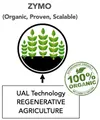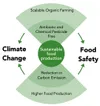
What We Do Focus on Regenerative Agriculture
Climate change and sustainability are the greatest challenges that we face today :
- The global population is expected to grow to about 10 billion people by 2050.
- Food production will have to increase by 70% before 2050 to meet population demands.
- Carbon dioxide (CO2) levels and other greenhouse gases rose to new records in 2019.
- Food Safety is a growing concern as regulators begin to taking serious action.
Altus Ecoventures Korea intends to partner with Singapore-based UAL Biotech to bring regenerative agriculture to Korea. The intention is for Altus Ecoventures to market and distribute UAL’s Bio-Fertilizer products in Korea and to set up a manufacturing facility in Korea to support sales and distribution of UAL products there.
Introducing UAL Biological Solutions
With the increasing urgency to improve food safety and fight climate change effects, UAL’s innovative Biological Solutions can disrupt current processes in agriculture, aquaculture, animal farming and industrial manufacturing towards increased productivity which impacts profitability, sustainability and environment.
UAL Regenerative Agriculture Enables Nature to Deliver
In agriculture, land is restored for future generations by:
- reducing the emission of greenhouse gases (nitrous oxide and carbon dioxide);
- eliminating harmful pesticides and antibiotics;
- rejuvenating acidic soils.
See our sustainable solution for palm oil plantations.
In aquaculture, clean water and food safety is ensured by:
- eliminating the use of antibiotics in shrimp & fish farming; and
- eliminating harmful chemicals in our water source.
For animal farm and feed, antibiotic and hormone free production is ensured by:
- reducing the emission of greenhouse gases (methane, ammonia and carbon dioxide); and
- eliminating the use of antibiotics.
UAL Agriculture Technology A Paradigm Shift in Agriculture

Evolution of Fertilizer Market

Yield is inconsistent, and chemicals create multiple concerns.

- Complete Elimination of Chemical NPK Fertilizers
- 5 -10 Kgs per Hectare compared to 1MT of Chemical Fertilizer
- Yield at par or more compared Chemical Fertiliser
- Cost at par or lower to Chemical Fertilizer
- Scalable Organic Farming
Agriculture Comparison of UAL versus Conventional Farming
Technology
- Organic Farming
- N,P,K from organic waste.
- Chemical Farming
- N,P,K from inorganic chemicals.
- UAL Technology
- Activates nutrients that are already in the soil and atmosphere to make it bio-available to the trees naturally by eliminating inhibitors on the soil.
Nature / Form
- Organic Farming
- Composting manure / vermi compost / organic waste.
- Chemical Farming
- Chemical synthesis urea , DAP, MOP.SSP etc.
- UAL Technology
- Bio fermentation product , eliminates need for chemical fertilizers.
Qty / ha. / crop
- Organic Farming
- 15-20MT per hectare.
- Chemical Farming
- 800kg to 1,000kg per Hectare.
- UAL Technology
- 5-10 kg/hectare for short crops , 10-20 kg/hectare for perennial crops.
Type
- Organic Farming
- Organic – non-scalable.
- Chemical Farming
- Non-organic – scalable.
- UAL Technology
- Organic-scalable, Indocert & Ecocert certified.
Environmental Impact
- Organic Farming
- Low impact , non-toxic depending on source.
- Chemical Farming
- High impact-toxic, major greenhouse gases, soil & ground water polluter, high pesticide use.
- UAL Technology
- Low impact, non-toxic to earthworms, animal & fishes, enhances disease resistance of plants.
Cost Point
- Organic Farming
- High costs.
- Chemical Farming
- Lower than conventional organic.
- UAL Technology
- Same costs as conventional chemical fertilizer, for certain crops costs are lower by 10-20%.
Yield Point
- Organic Farming
- 30 to 40% lower than chemical N, P, K.
- Chemical Farming
- High yield.
- UAL Technology
- Even higher yield, same if not 15% higher than chemical fertilizer farming.
Soil Fertility
- Organic Farming
- Soil remediation in 2-3 years.
- Chemical Farming
- Destroys soil bio-diversity, soil degradation.
- UAL Technology
- Sustained soil remediation , rejuvenation & soil fertility improvement.
Agriculture ZYMO Series
Our ZYMO series of product applications represent UAL's targeted formulation approach to the agriculture market. UAL can be quickly and effectively customize and formulate new product applications for specific crop applications.

ZYMO even extends beyond nutrients into pest control and disease control, clearly demonstrating the ability of UAL's solution platform to extend the full array of solutions that meets the needs of food production.

UAL Aquaculture Technology Breakthrough in Aquaculture

UAL's unique and innovative aquaculture technology enables shrimp and fish farms to overcome problems faced by current farming practices:
- controlling gram +ve and gram –ve bacteria, virus & vibrio while culture is present in water;
- removing the use of antibiotics in high density shrimp & fish farming; and
- resolving issues such as ammonia, nitrate, H2S etc.
This substantially improves the shrimp and fish farms' ability to get successful harvests consistently with higher survival rates.
Aquaculture Value Proposition
Controlling Pathogens in Water
A combination of two organic products, which are not harmful to shrimp or fish present in the water but has the ability control the growth of pathogens.
The same combination also breaks down sludge at the bottom of pond into fertilizer and nutrients to prevent ammonia, nitrate, carbon dioxide, etc., which are toxic to shrimp, fish and surrounding environment.
Managing Disease - A Preventive Approach
Maintain mucosa in gut and ability to control specific pathogens but allows certain beneficial gut microflora to flourish.
Aquaculture Case for Shrimp Farming
Water Quality
- pH Balance
- Oxygen level
- Ammonium build up
- Hydrogen sulphide levels
- Current Solution
- Involves the application of a dozen or more chemical products that are applied primarily as a reaction to water quality changes and health related symptoms of the batch.
- UAL Solution
- The Enzymes break down feeds that sink to the pond bottom and breaks them into soluble and available nutrients for the stock thus avoiding buildup of ammonia and H2S which in turn alter the pH and oxygen levels in the pond. In summary, UAL's solution:
- Controls vibrio, bacteria and virus
- Controls NH, No2, H2S, CO, CO2, etc.
- Breaks down sludge and sediments
Health of Shrimps
- Gut health
- Free from harmful bacteria
- Current Solution
- Antibiotics are applied through the feed additives to constantly keep the gut free of harmful bacterial infection.
- UAL Solution
- Less prone to disease due to healthy gut which prevents the water from being infected with outbreaks of diseases and can be managed without addition of antibiotics:
- Controls white muscle, white faeces, EMS, RMS
- Reduces waste
- Increase nutrient uptake
- Maintains gut pH
Profitability
- Yield and costs.
- Current Solution
- High costs.
- UAL Solution
- Lower material cost versus chemicals and antibiotics. Improve health and disease control leading to lower mortality rate.
Sustainability
- Current Solution
- Not sustainable.
- UAL Solution
- CO2 abatement, mitigate impacts to coastal ecosystems from pond discharges and address food safety concerns with elimination of chemicals and anti-biotics.
UAL Animal Farm & Feed Technology Organic Farm Management Approach

Farm Environment
- Manure issues – wet and deep litter
- Pathogen control
- Fly control
- Effluent treatment
Drinking Water & Gut Health
- Pathogen and water born diseases control
- Maintain mucosa and gut health
- Eliminate use of antibiotics
Animal Feed
- Feed preservation - free from organic acids and antibiotics
Animal Health
- Manage heat stress
- Protect against airborne pathogen loads
- Manage nutritional deficiencies
Animal Farm and Feed UAL Technology Breakthrough
UAL caters to an increasing demand for organically fed and grown farm produce. UAL has successfully introduced an organic program that enables high density farming without use of antibiotics, growth hormones or chemicals.
UAL Technology overcomes the following issues that is caused by current farm practices:
- innovative approach to resolve farm waste which is the origin of many diseases and environment issues;
- controls gram +ve and gram –ve bacteria, virus in farms substantially reduces use of antibiotics in farms.
Animal Farm and Feed Value Proposition
Managing Animal Waste and Control Pathogens
UAL has developed a solution that can rapidly convert faeces/manure to compost there by significantly reducing the problem of pathogens, flies, odor and maggots.
UAL has developed a organic solution that controls growth of pathogens in faeces and repels flies and insects that act as vectors for carrying disease.
Managing Disease - A Preventive Approach
Maintain mucosa in gut and ability to control specific pathogens but allows certain beneficial gut microflora to flourish.
Animal Farm and Feed Case for Poultry Farming
Water Quality & Farm Environment
- Current Solution
- Antibiotics are used for management of bacteria and pathogens.
- UAL Solution
- Water quality management which prevents the intake of contaminated water leading to digestive concerns.
- Litter management - By introducing enzymes that slow the formation of ammonia and fly propagation leading to less ammonia build up in the house.
Gut Health
- Free from harmful bacteria
- Current Solution
- Antibiotics are applied through the feed additives to constantly keep the gut free of harmful bacterial infection.
- UAL Solution
- Gut functionality by preventing harmful microbial infections:
- Pathogen and water born diseases control
- Maintain mucosa and gut health
- Eliminate use of antibiotics
Profitability
- Yield and costs.
- Current Solution
- High costs.
- UAL Solution
- Improve feed efficiency leading to potential lower input cost of feeds.
- Improve health and disease control leading to lower mortality rates.
- Revenue premium for organic certified products.
Sustainability
- Current Solution
- Not acceptable.
- UAL Solution
- Reduction in CO2 emissions and address litter pollution from manure fertilizers. Addresses food safety concerns.

